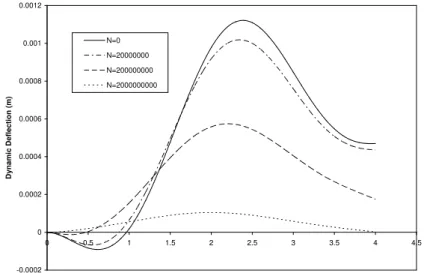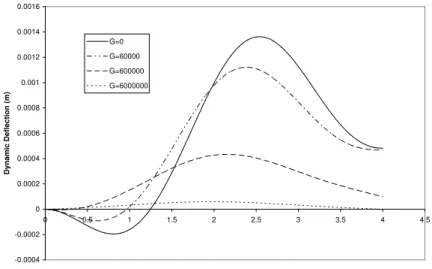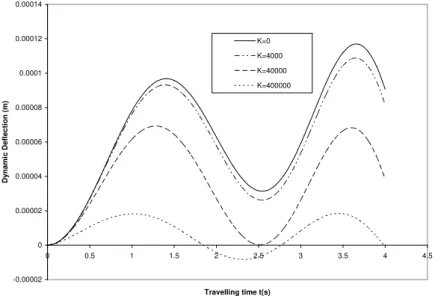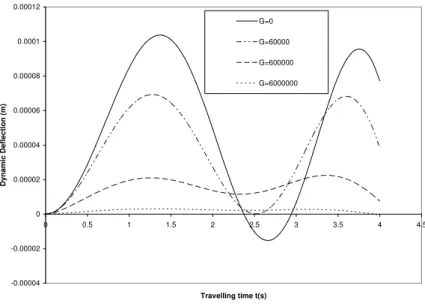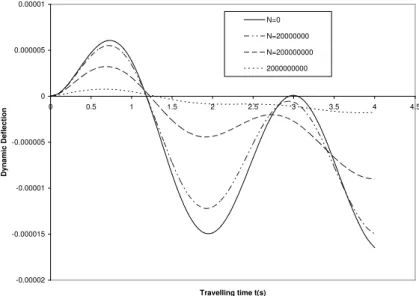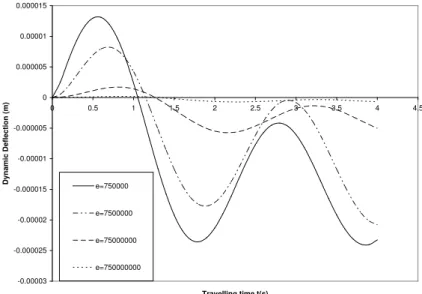Abstract
A procedure involving spectral Galerkin and integral transfor-mation methods has been developed and applied to treat the prob-lem of the dynamic deflections of beam structure resting on bi-parametric elastic subgrade and subjected to travelling loads. The case of the response to moving constant loads of this slender mem-ber is first investigated and a closed form solution in series form describing the motion of the beam while under the actions of the travelling load is obtained. The response under a variable magni-tude moving load with constant velocity is finally treated and the effects of prestressed, foundation stiffness, shear modulus and damping coefficients are investigated. Results in plotted curves indicate that these structural parameters produce significant effects on the dynamic stability of the load-beam system. Conditions under which the beam-load system may experience resonance phenome-non are also established some of these findings are quite useful in practical applications.
Keywords
Dynamic deflection, Dynamic stability, Resonance, Galerkin method, Damping coefficient
Deflection profile analysis of beams on two-parameter elastic
subgrade
1 INTRODUCTION
Study concerning the subject of moving load systems has become increasingly important owing to its range of applications in transportation industries, aerospace engineering and related fields. Elastic structures are very useful in many engineering fields, thus their dynamic behaviours when under the action of travelling loads of different forms have received extensive attention in the open literature [1-8]. When these important engineering structures are resting on an elastic foundation, the structure-foundation interaction effects play significant roles in their response behaviour and alter the dynamic states of the structures from those vibrating in the absence of foundation [9]. Hence, the dynamic be-haviour of structures on elastic foundation is of great importance in structural, aerospace, civil, me-chanical and marine engineering applications.
Consequently, it is important to clarify the influence of the foundation on the behaviour of elastic structures in engineering designs. Furthermore, to accurately assess the dynamic response of
B. Omolofe *
Department of Mathematical Sciences, School of Sciences, The Federal University of Technol-ogy, PMB 704, Akure, Ondo state, Nigeria.
Received 15 Dec 2011 In revised form 05 Mar 2012
any structural member on elastic foundations, a mechanical model is required to predict the interaction effects between such structures and foundations. Beams on elastic foundation and under the actions of the moving loads have received a considerable attention in literature; see for example references [10-18]. However, most of these works employed the simplest mechanical model which was developed by Winkler and generally referred to as a one-parameter model. The deficiency of this model is that it assumes no interaction between the springs, so it does not accurately represent the characteristics of many practical foundations [19]. Thus to overcome the deficiencies inherent in Winkler formulation, a two-parameter foundation models which takes into account the effect of shear interactions between springs has been suggested. Nonetheless, dynamic analysis of elastic structures on a two-parameter foundation model has received little attention in the open literature. It is observed that, when the pa-rameters of the foundation mechanical models are constant along the span of the structure, the differ-ential equation has constant coefficients, and the solution can be given as a linear combination of ele-mentary functions, but if the foundation parameters vary along the structures, it is difficult to obtain the exact solutions of these differential equations in most cases, and a numerical technique is resorted to. Nevertheless, an exact analytical procedure is desirable as solution so obtained sheds more light on some vital information about the vibrating system. Thus, in this paper, an analytical approach is devel-oped to assess the dynamic response behaviour of elastic beams resting on two-parameter elastic foundation and subjected to travelling loads. To classify the influence of the foundation model and other important structural parameters on the dynamic response of the beams to moving loads, several numerical examples will also be presented. Effects of different types of moving loads on the beams will be investigated.
2 THE MATHEMATICAL FORMULATION
Consider a structurally damped elastic beam resting on a two-parameter elastic subgrade and under the actions of concentrated travelling load. The differential equation governing the motion of such beam is given by
(1)
where the prime and the over-dot are the partial derivatives with respect to the spatial coordinate x
and the time t respectively, E is the modulus of elasticity, I is the constant moment of inertia, Z x t
(
,)
is the transverse deflection of the beam, N is the axial force, m is the mass of the beam per unit
length, e0 is the damping coefficient, F(x) is the variable elastic foundation, G(x) is the non-uniform
shear rigidity of the foundation and P(x,t) is the time dependent concentrated travelling load. The boundary conditions at the end x = 0 and end x = L are given as
(
0,)
0(
,)
Z t = = Z L t
,
(
)
(
)
2
2
0, ,
0
Z t Z L t
x x
¶ ¶
= =
¶ ¶
(2)
and the initial conditions are also given as
(3)
(4)
and
(5)
where F0 and G0 are the foundation and shear rigidity constants respectively.
Substituting (4) and (5) into (1) one obtains
(6)
In what follows, we seek to calculate the dynamic deflection of the vibrating system for
dif-ferent type of dynamic load .
3 FORCED VIBRATIONS OF BEAMS SUBJECTED TO CONSTANT MAGNITUDE TRAVELLING LOAD
If the travelling concentrated load is assumed to be of the constant magnitude then, the dynamic load
(
,)
P x t can be written as
(7)
Thus, in view of (7) equation (6) can be rewritten as
(8)
Equation (8) describes the motions of a prestressed homogeneous beam resting on a two-parameter elastic subgrade and subjected to fast travelling forces. Closed-form solution to the fourth order partial differential equation (8) governing the motion of the elastic thin member under the action of concentrated moving forces is now sought.
3.1 Solution procedures
The approximate analytical method due to Galerkin extensively discussed in [4] is employed to ap-proximate the solution of the boundary-initial-value problem (1), (2). According to this technique,
(9)
where Qi
( )
t are coordinates in modal space and P xi( )
are the normal modes of vibration written as(10)
No difficulty arises at all to show that for a beam with simply supported end conditions, taking into account equation (10), equation (9) can be written as
(11)
Substituting equation (11) into the governing equation (8), one obtains
(12 )
which after some simplifications and rearrangements yields
(13)
To determine the expression forQi
( )
t , the expression on the LHS of equation (13) is required tobe orthogonal to the function . Thus, multiplying equation (13) by and integrating
with respect to x from x=0 to x=L, leads to
(14)
where
,
,
,
,
,
,
Noting the property of the dirac delta function
(16)
and considering only the ith particle of the system, equation (14) can then be written as
(17)
where
,
and
(18)To obtain the solution of the equation (17), it is subjected to a Laplace transform defined as
(19)
where s is the Laplace parameter. Applying the initial conditions (3), one obtains the simple algebra-ic equation given as
(20)
which when simplified further yields
(21)
where
and
(22)In what follows, we seek to find the Laplace inversion of equation (21). To this effect, the follow-ing representations are adopted
,
and
(23)So that the Laplace of (21) is the convolution of and defined as
(24)
Thus, the Laplace inversion of (21) is given by
(25)
where
and (26)
Thus, in view of (25), taking into account (26) one obtains
(27)
Substituting equation (27) into equation (9) leads to
Equation (28) represents the transverse displacement response of the damped beam resting on a two-parameter elastic subgrade and under the actions of constant magnitude moving loads.
4 FORCED VIBRATIONS OF BEAMS SUBJECTED TO EXPONENTIALLY VARYING MAGNITUDE TRAVELLING LOAD
In this section, the dynamic response of the elastic thin beam resting on a two-parameter elastic sub-grades to exponentially varying load is scrutinized. Thus, for the purpose of example in this section
the dynamic load P x t
(
,)
is taken in this section to be of the form(29)
Substituting equation (29) into equation (6), following the same arguments as in the previous section, after some simplification and rearrangements one obtains
(30)
where all parameters are as previously defined.
Using the property of Dirac delta already alluded to, equation (30) can be rewritten as
(31)
Solving equation (31) in conjunction with the initial conditions, yields
(32)
Substituting equation (31) into equation (9) one obtains
(33)
5 FORCED VIBRATIONS OF BEAMS SUBJECTED TO HARMONICALLY VARYING MAGNITUDE TRAVELLING LOAD
In this section, the dynamic response of the elastic thin beam resting on two-parameter elastic sub-grades to exponentially varying load is scrutinized. Thus, for the purpose of example in this work the
traversing load P x t
(
,)
tis taken to be of the form(34)
Substituting equation (34) into equation (6), following the same arguments as in the previous section, after some simplification and rearrangements one obtains
(35 )
where all parameters are as previously defined.
Again, using the property of dirac delta , quation (35) can be rewritten as
(36)
Using trigonometric identity, equation (36) can further be written as
(37)
Following the same arguments and procedures listed in section 3.0, one obtains the solution of equation (37) as
(38)
where
,
,
(39)(40)
which represents the transverse displacement response of the damped beam resting on a two-parameter elastic subgrade and under the actions of harmonic variable magnitude travelling loads.
6 DISCUSSION OF ANALYTICAL SOLUTIONS
This section seeks to examine and establish the conditions under which the vibrating system may grow without bound. This phenomenon constitutes great concern in dynamical system problems. From equation (28), it is evidently clear that, an axially prestressed damped beam resting on a two-parameter elastic subgrade and under the actions of constant magnitude moving load will experience a state of resonance whenever
,
or
(41)and the velocity, known as critical velocity at which this occur is given as
or
(42)Similarly, equation (33) depicts that an axially prestressed damped beam resting on a two-parameter elastic subgrade and under the actions of exponentially varying magnitude travelling load will experience a state of resonance whenever
,
,
,
or
(43)and the velocity at which this occur is given as
or
,
(44)While, equation (40) depicts that an axially prestressed damped beam resting on a two-parameter elastic subgrade and under the actions of harmonic variable magnitude travelling load will experi-ence resonance phenomenon whenever
,
,
,
(45)or
(46)
7 RESULTS AND DISCUSSION
In this section, the foregoing analysis is illustrated by considering an isotropic beam structure of
modulus of elasticity E = N/m2, the moment of inertia I = m4, the beam
span L = 12.192m and the mass per unit length of the beam m=2758.291 Kg/m. The moving loads
in both the cases of travelling constant loads and varying magnitude moving load is assumed to be
. The values of foundation moduli is varied between 0N / m3 and 400000N / m3,
the values of axial force N is varied between 0 N and and the values of shear modulus G
is varied between 0N / m3 and 6000000 .
Figure 1 depicts the dynamic deflections of structurally damped beam resting on elastic founda-tion and subjected to constant magnitude loads travelling at constant velocity. It is clearly seen that for fixed values of foundation rigidity K, shear stiffness G and damping coefficient e, the transverse displacement response of the beam decreases as the values of the prestress function N increases. Similarly, figures 5 and 9 display for fixed values of foundation rigidity K, shear stiffness G, damping coefficient e and for various values of prestress function N the transverse displacement response of structurally damped beam to variable harmonic magnitude and exponentially varying moving loads respectively. It is found also that the dynamic deflections of the beam increases as the values of axial force N reduces for fixed values
Figure 1 Transverse displacement of structurally damped beam for various values of axial force N and for fixed value of Foundation stiffness K, shear modulus G and damping coefficient e
-0.0002 0 0.0002 0.0004 0.0006 0.0008 0.001 0.0012
0 0.5 1 1.5 2 2.5 3 3.5 4 4.5
Travelling time t (s)
D
yn
am
ic D
ef
lect
io
n
(
m
)
Figure 2 Deflection profile of a structurally damped beam for various values of foundation modulus K and for fixed values of Axial force N, shear force G and damping coefficient e
Figure 3 Displacement response of structurally damped beam subjected to constant magnitude moving load for various values of the shear modulus G and for fixed values of the Axial force N, Foundation stiffness k and damping coefficiente
-0.0005 0 0.0005 0.001 0.0015 0.002
0 0.5 1 1.5 2 2.5 3 3.5 4 4.5
Traveling time t (s)
D
yn
am
ic D
ef
lect
io
n
(
m
)
K=0 K=4000 K=40000 K=400000
-0.0004 -0.0002 0 0.0002 0.0004 0.0006 0.0008 0.001 0.0012 0.0014 0.0016
0 0.5 1 1.5 2 2.5 3 3.5 4 4.5
Travelling time t (s)
D
yn
am
ic D
ef
lect
io
n
(
m
)
Figure 4 Transverse response of structurally damped beam to constant magnitude moving load for various values of the damping coefficient e and for fixed values of Axial force N, Foundation stiffness K and Shear modulus G
Figure 5 Transverse response of a structurally damped beam to constant magnitude moving load for various values of damping coefficient e and for fixed values of Axial force N, Foundation stiffness K and Shear modulus G
-0.0005 0 0.0005 0.001 0.0015 0.002 0.0025 0.003
0 0.5 1 1.5 2 2.5 3 3.5 4 4.5
Travelling time t (s)
D
yn
am
ic D
ef
lect
io
n
(
m
)
e=750000 e=7500000 e=75000000 e=750000000
-0.0002 0 0.0002 0.0004 0.0006 0.0008 0.001 0.0012 0.0014 0.0016 0.0018
0 0.5 1 1.5 2 2.5 3 3.5 4 4.5
Travelling time t(s)
D
yn
am
ic D
ef
lect
io
n
(
m
)
Figure 6 Transverse displacement of structurally damped beam subjected to exponentially varying magnitude load for various values of axial force N and for fixed value of Foundation stiffness K, shear modulus G and damping coefficient e
Figure 7 Deflection profile of a structurally damped beam under the actions of exponentially varying loads for various values of foundation modulus K and for fixed values of Axial force N, shear modulus G and damping coefficient e
-0.00001 0 0.00001 0.00002 0.00003 0.00004 0.00005 0.00006 0.00007 0.00008
0 0.5 1 1.5 2 2.5 3 3.5 4 4.5
Travelling time t(s)
D
yn
am
ic D
ef
lect
io
n
(
m
)
N=0
N=20000000
N=200000000
N=2000000000
-0.00002 0 0.00002 0.00004 0.00006 0.00008 0.0001 0.00012 0.00014
0 0.5 1 1.5 2 2.5 3 3.5 4 4.5
Travelling time t(s)
D
yn
am
ic D
ef
lect
io
n
(
m
)
Figure 8 Displacement response of structurally damped beam to exponentially varying magnitude moving load for various values of the shear modulus G and for fixed values of the Axial force N, Foundation stiffness K and damping coefficient e
Figure 9 Transverse response of a structurally damped beam to exponentially varying magnitude moving load for various values of damping coefficient e and for fixed values of Axial force n, Foundation stiffness K and Shear modulus G
of other parameters. In figure 2, the deflection profile of the structurally damped beam for vari-ous values of the foundation rigidity K and for fixed values of the shear stiffness G, damping coeffi-cient e and the prestress function N is displayed. It is shown that as the values of the foundation ri-gidity K increases, the dynamic deflection of the beam decreases for fixed values of the shear stiffness G, damping coefficient e and the prestress function N. In figures 6 and 10, for various values of foun-dation rigidity K and for fixed values of the shear stiffness G, damping coefficient e and prestress function N the transverse displacement response of structurally damped beam to variable harmonic magnitude and exponentially varying moving loads respectively are shown. Similarities between
-0.00004 -0.00002 0 0.00002 0.00004 0.00006 0.00008 0.0001 0.00012
0 0.5 1 1.5 2 2.5 3 3.5 4 4.5
Travelling time t(s)
D yn am ic D ef lect io n ( m ) G=0 G=60000 G=600000 G=6000000 -0.00004 -0.00002 0 0.00002 0.00004 0.00006 0.00008 0.0001 0.00012
0 0.5 1 1.5 2 2.5 3 3.5 4 4.5
Travelling time t(s)
these figures and figure 2 are clear. Figures 3, 7 and 11 showcase the effects of the shear stiffness on the flexural motions of beam structure resting on two-parameter elastic foundation and under the action of various laods travelling at constant velocity respectively. It is found from all these figures that for fixed values of foundation rigidity K, damping coefficient e , prestress function N and for var-ious values of shear stiffness G, the dynamic deflection of the beam structure decrease as the values of the shear stiffness G increases.
Figure 4 illustrates the dynamic behaviour of structurally damped beam resting on elastic founda-tion and subjected to constant magnitude loads travelling at constant velocity. It is shown that for fixed values of foundation rigidity K, shear stiffness G and the prestress function N, the transverse displacement response of the beam decreases as the values of the damping coefficient e increases. Similarly, figures 8 and 12 display for fixed values of foundation rigidity K, shear stiffness G, prestress function N and for various damping coefficient e the transverse displacement response of structural-ly damped beam to variable harmonic magnitude and exponentialstructural-ly varying moving loads respective-ly. It is observed that the dynamic deflections of the beam increases as the values of damping coeffi-cient e dereases for fixed values of foundation rigidity K, shear stiffness G and prestress function N.
The comparison of the dynamic behaviour of the axially prestressed beam resting on two-parameter elastic foundation and under the actions of constants and variable magnitude loads is shown in figure 13. From this figure, it is observed that higher values of the structural parameters namely axial force N, foundation rigidity K, shear stiffness G and damping coefficient e are required for a more noticeable effects in the case of the dynamical systems involving variable magnitude loads than those involving constant magnitude moving loads.
Figure 10 Transverse displacement of structurally damped beam subjected to harmonic variable magnitude load for various values of axial force N and for fixed value of Foundation stiffness K, shear modulus G and damping coefficient e
-0.00002 -0.000015 -0.00001 -0.000005 0 0.000005 0.00001
0 0.5 1 1.5 2 2.5 3 3.5 4 4.5
Travelling time t(s)
D
yn
am
ic D
ef
lect
io
n
Figure 11 Deflection profile of a structurally damped beam under the actions of exponentially varying loads for various values of foundation modulus K and for fixed values of Axial force N, shear modulus G and damping coefficient e
Travelling time t(s)
Figure 12 Displacement response structurally damped beam to harmonic variable magnitude moving load for various values of the shear modulus G and for fixed values of the Axial force N, Foundation stiffness K and damping coefficient e
-0.000025 -0.00002 -0.000015 -0.00001 -0.000005 0 0.000005 0.00001
0 0.5 1 1.5 2 2.5 3 3.5 4 4.5
Travelling time t(s)
D
yn
am
ic D
ef
lect
io
n
(
m
)
K=0
K=4000
K=40000
K=400000
-0.00003 -0.000025 -0.00002 -0.000015 -0.00001 -0.000005 0 0.000005 0.00001
0 0.5 1 1.5 2 2.5 3 3.5 4 4.5
D
yn
am
ic D
ef
lect
io
n
(
m
)
Figure 13 Transverse response of a structurally damped beam to harmonic variable magnitude moving load for various values of damping coefficient e and for fixed values of Axial force N, Foundation stiffness K and Shear modulus G
Figure 14 Comparison of the deflection profile of a structurally damped beam resting on two-parameter elastic foundation and under the influence of moving loads for fixed values of Axial force N, Foundation stiffness K, Shear modulus G
8 CONCLUSION
The dynamic response of a prestressed homogeneous beam system continuously supported by elas-tic foundation to fast travelling loads of different forms was investigated. The dynamic deflections of this slender member when under the actions of moving loads are obtained in closed forms. Condi-tions under which the beam-load system may experience resonance phenomenon are established. The calculated deflections are clearly presented in plotted curves and discussed. The effects of the damping, pretrsssed, and stiffness of the viscoelastic layer on the beam deflections are scrutinized. Results of analysis show that the dynamic deflections of the beam increases as the values of the damping coefficient e increases. It is also found that increasing the values of the foundation rigidity K, shear stiffness G and prestress function N decreases the deflection of the beam significantly.
-0.00003 -0.000025 -0.00002 -0.000015 -0.00001 -0.000005 0 0.000005 0.00001 0.000015
0 0.5 1 1.5 2 2.5 3 3.5 4 4.5
Travelling time t(s)
D yn am ic D ef lect io n ( m ) e=750000 e=7500000 e=75000000 e=750000000 -0.0002 0 0.0002 0.0004 0.0006 0.0008 0.001 0.0012
0 0.5 1 1.5 2 2.5 3 3.5 4 4.5
Travelling time t(s)
thermore, it is observed that higher values of the structural parameters namely axial force N, founda-tion rigidity K, shear stiffness G and damping coefficient e are required for a more noticeable effect in the case of the dynamical systems involving variable magnitude loads than those involving constant magnitude moving loads.
References
[1]M. Milormir, M. M. Stanisic, and J. C. Hardin, On the response of beams to an arbitrary number of concentrat-ed moving mases. Journal of the Frankling Institute, Vol. 287, No 2, 1969.
[2]L. Fryba, S. Nakagiri and N. Yoshikawa, Stochastic finite elements for a beam on a random foundation with uncertain damping under a moving force. Journal of sound and vibration 163, 1993,31-45
[3]H. P. Lee, Dynamic response of a beam with moving mass. Journal of sound and vibration. 191,( 1996) 289-294.
[4]S. T. Oni and B. Omolofe Dynamic behaviour of non-uniform Bernoulli-Euler beams subjected to concentrat-ed loads Traveling at varying velocities.ABACUS, vol. 32, No 2A, pp 165-191, 2005.
[5]B. Omolofe, S. T. Oni and J. M. Tolorunshagba On the Transverse Motions of Non-prismatic Deep beam Under the actions of Variable Magnitude Moving Loads. Latin American Journal of Solid and structures. Vol. 6, pp 153-167, 2009.
[6]G. Muscolino, A. Palmeri, Response of beams resting on viscoelastically damped foundation to moving oscilla-tors. International Journal of solid and Srtuctures Vol. 44, pp. 1317-1336, 2007.
[7]W. L. Li, X. Zhang, J. Du and Z. Liu; An exact series solution for the transverse vibration of rectangular plates with general elastic boundary supports. Journal of Sound and Vibrations, 321, pp 254-269, 2009.
[8]F. F. Calim; Free and forced vibrations of non-uniform composite beams. Composite Structures, 88, pp 413-423, 2009.
[9]B. Ugurlu, A Kutlu, A Ergin, M. H. Omurtag; Dynamics of a rectangular plate resting on an elastic foundation and partially in contact with a quiescent fluid. Journal of Sound and Vibration 317, pp 308-328, 2008. [10]J. Clastornik , M. Eisenberger, D. Z. Yankelevsky and M. A. Adin; Beams on variable Winkler elastic
founda-tion. Journal of Applied Mechanics, ASME, 53(4), 925-928, 1986.
[11]D. P. Thambiratnam and Y. Zhuge; Dynamics analysis of beams on an elastic foundation subjected to moving loads. Journal of Sound and Vibration, Vol. 198, No 2, pp 149-169, 1996.
[12]U. S. Gupta, A. H. Ansari and S. Sharma; Buckling and vibration of polar orthotropic circular plate resting on Winkler foundation, Journal of Sound and Vibration Vol. 297, No 3-5, pp 457-476, 2006.
[13]K. N. Saha; Dynamic stability of a rectangular plate on non-homogeneous Winkler foundation. Computer structure ,Vol. 63, No. 6, pp 1213-1222, 1997.
[14]H. Matsunaga; Vibration and stability of thick plates on elastic foundations. Journal of Engineering Mechan-ics, Vol. 126, No. 1, pp 27-34, 2000.
[15]M.-H. Huang, D. P. Thambiratnam; Deflection response of plate on Winkler foundation to moving accelerated loads. Engineering Structures, 23, pp 1134-1141, 2001
[16]L. Sun, and F. Luo, “Steady-State Dynamic Response of a Bernoulli–Euler Beam on a Viscoelastic foundation Subject to a Platoon of Moving Dynamic Loads”, Journal of Vibration and Acoustics, Vol. 130, pp 0510021-0510021, 2008.
[17]J. Ying, C. F. Lu, W. Q. Chen; Two-dimensional elasticity solutions for functionally graded beams resting on elastic foundations. Computer Structure Vol. 84, No 3, pp 209-219, 2008.
[18]Y. H. Chen, Y. H. Huang and C. T. Shih; Response of an infinite Timoshenko beam on a viscoelastic foundation to a harmonic moving load. Journal of Sound and Vibration Vol. 241, No 5, pp 809-824, 2001.
